
Think you might have tennis elbow? Although this overuse injury can be sharply painful, physical therapy can help relax tight muscles and relieve tendon pain. Keep reading for a sample home exercise program for tennis elbow, including tennis elbow exercises and stretches.
What is Tennis Elbow?
The technical term for tennis elbow is “lateral epicondylitis,” when the tendons that connect the wrist and forearm deteriorate, resulting in inflammation and pain. This deterioration is like the fraying of a rope, happening gradually over time and especially weakening around midlife. Overuse of the muscles and tendons—through repetitive motion and stress, for example—will accelerate the process.
You don’t have to be an athlete to develop tennis elbow. It’s a common occupational hazard for those who regularly perform repetitive tasks, such as carpenters, cooks, musicians, and plumbers. You may be developing tennis elbow if you feel pain when gripping things like jars and doorknobs. Another telltale sign is experiencing pain when reaching forward to lift things, especially with your palm facing down.
If in doubt, ask a physical therapist, who will be able to assess your pain and give you an appropriate plan to follow. Chances are, what they advise will look similar to the stretches and exercises outlined in this post.
Physical Therapy for Tennis Elbow
To rehabilitate the tearing tendons in your wrist and forearm, you’ll need a careful combo of stretching and exercises. The most important ingredient, however, is consistency. Rehabilitation takes time, and a full home exercise program for tennis elbow usually requires 12 weeks of therapy, performed every day. So let’s get started!
3 Tennis Elbow Stretches
Stretching is a key component of physical therapy. It encourages the muscles and tendons to lengthen, helping improve flexibility and deflect injury. Even injured tendons need to be stretched, but not in a way that is painful. You may feel soreness or “tightness” as you stretch, but ease up if you feel pain, a sign your tendon may be fraying or tearing at its insertion.
I always urge my patients to ease gradually into stretching, emphasizing frequency over intensity. It’s good practice to stretch at least every 2 hours and anytime you feel tightness in your elbow. You’ll also need to stretch before and after exercising.
Below I give you 3 tennis elbow stretches. The first includes a basic and advanced version; start with the basic stretch and move to the advanced stretch after a few days, if it isn’t painful.
1. Basic Tennis Elbow Stretch
Start with your elbow straight, arm outstretched, and palm facing down. Next, keeping your arm level, slowly lower your fingers by flexing your wrist. Finally, using your other hand, gently push your flexed wrist down, all the while maintaining a straight elbow.



Hold this stretch for 15–20 seconds before releasing. Repeat every 2 hours.
Advanced Version
Once this stretch feels fully comfortable and pain-free, add the following step.
With your arm outstretched, elbow straight, and wrist flexed, use your other hand to rotate your forearm with your pinky finger towards the ceiling.
Hold this for 15–20 seconds, repeating every two hours.
2. Upper Trap Stretch
In addition to stretching your forearm, it’s helpful to stretch proximal muscles, such as your shoulders and neck, that could be contributing to the tightness in your elbow. For example, slouching rolls your shoulders forward, which rotates the arms inward and puts a greater strain on the lateral elbows. By stretching your upper traps, you can help soothe the muscles upstream from your elbow and experience relief all the way down your arm.


For this stretch, sit tall and tuck the hand of your affected arm under your bottom to stabilize your shoulder. Next, tilt your head away from the affected side, bringing your ear to your other shoulder and elongating your neck on the affected side.
You can deepen this stretch by gently pressing down on the side of your head as you tilt it to your other shoulder.
Hold for 20–30 seconds, repeating every two hours. Even if you don’t have tennis elbow in your other arm, it’s a good idea to repeat this stretch on the other side too.
3. Scapular Retraction
Part stretch, part exercise, scapular retraction is a movement we use in PT to help promote better posture in the upper back and shoulders. Instead of rolling your shoulders forward, you’ll square them, helping loosen tight neck and back muscles from your ears to your hands.
Sit or stand tall, and squeeze your shoulder blades together. Imagine your shoulder blades sliding “down and back,” being careful not to hike them up as you squeeze. Don’t overextend this movement; just squeeze and release, holding for 2–3 seconds each time. Repeat 20 times every couple hours.
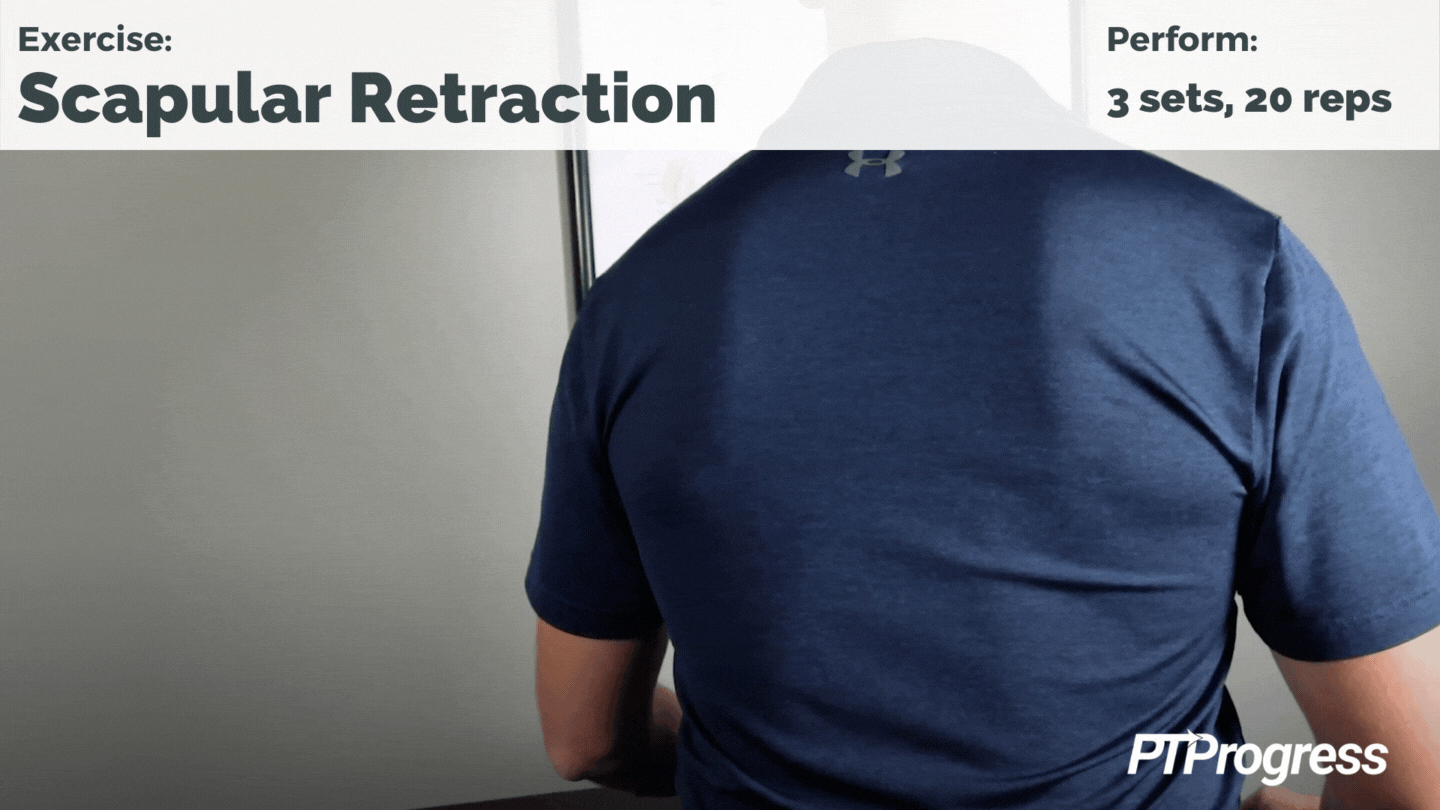
5 Tennis Elbow Exercises
With an injured tendon, you can’t exercise the way you used to. But exercise is vital for strengthening the muscle and speeding its recovery. To protect your injury, many tennis elbow exercises begin with the tendon in eccentric contraction, or the lengthening form of the muscle as opposed to its shortening form. Strengthening the muscle while it’s shortening can further irritate the tendon.
Before starting the exercises, therefore, practice performing an eccentric contraction, detailed below. This simple movement will serve as the foundation for more exercises, so it’s important to learn how to perform it correctly and pain-free.
Remember, these movements may cause soreness afterwards, but they shouldn’t cause pain, so stop exercising if you experience sharp pain.
Performing an Eccentric Contraction
Hold your injured wrist out in front of you. Keeping your arm stable, use your other hand to manually lift your injured wrist. Then take your other hand away and slowly lower your affected wrist, to a count of 5 seconds. Relax, then repeat, being careful not to let your injured tendon assist in lifting your wrist. Your injured wrist should be doing work only on the way down, while your other hand “carries it” to the top of the movement.
You can watch me demonstrate this movement—and others from this post—in this video.
Once you feel comfortable performing an eccentric contraction without pain, try the following exercises.
1. Eccentric Extension
Sit with your injured wrist at the edge of a table, palm down. With your opposite hand, manually lift your wrist above the table. Then remove your other hand and slowly lower your affected wrist to a count of 5 seconds.
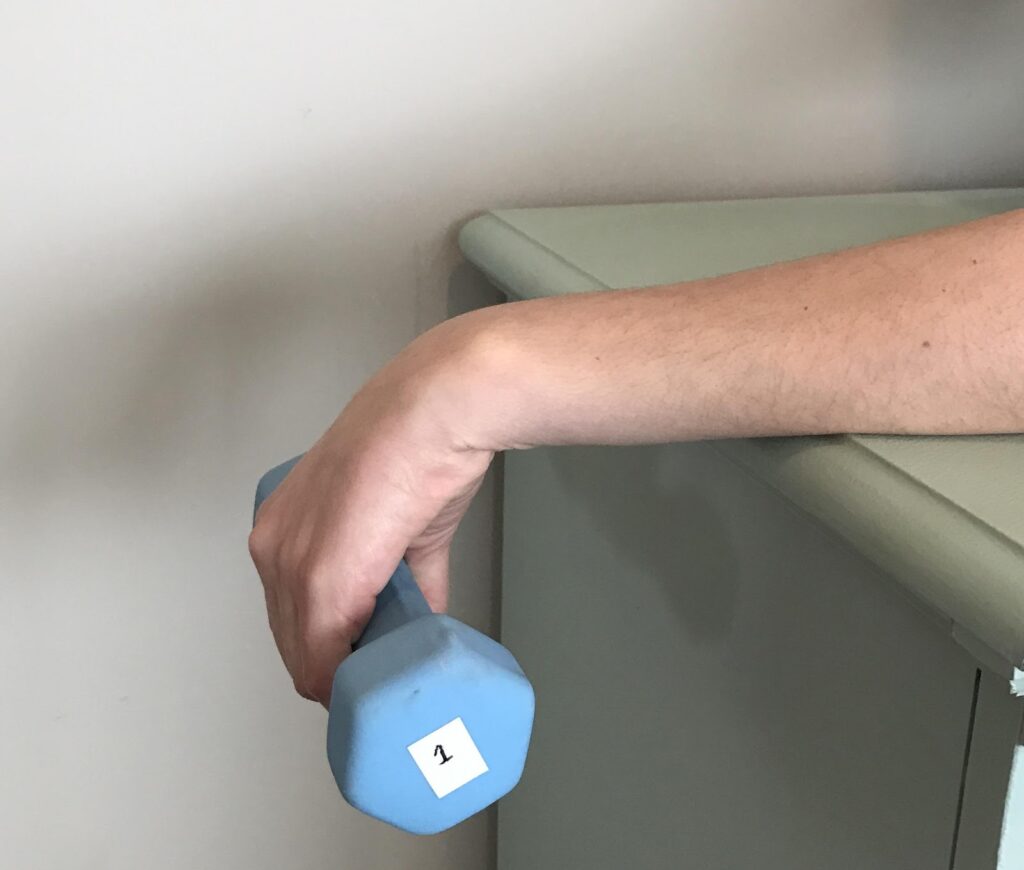
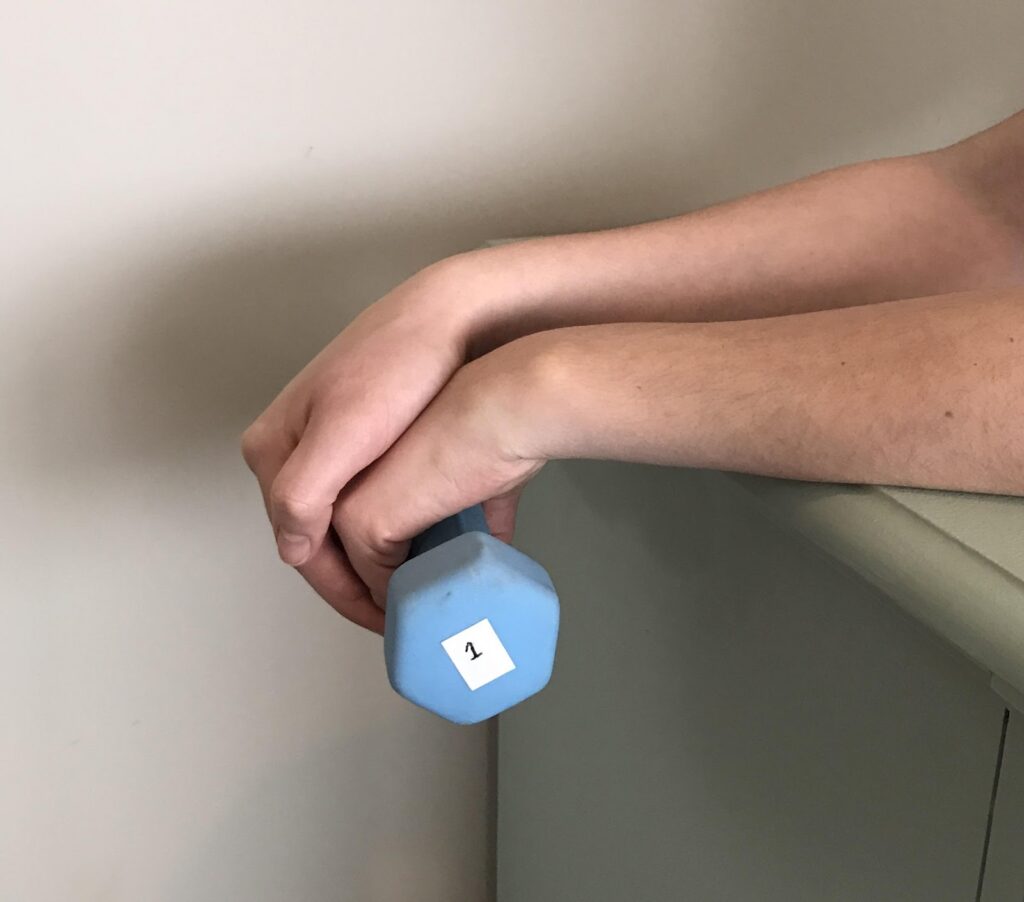
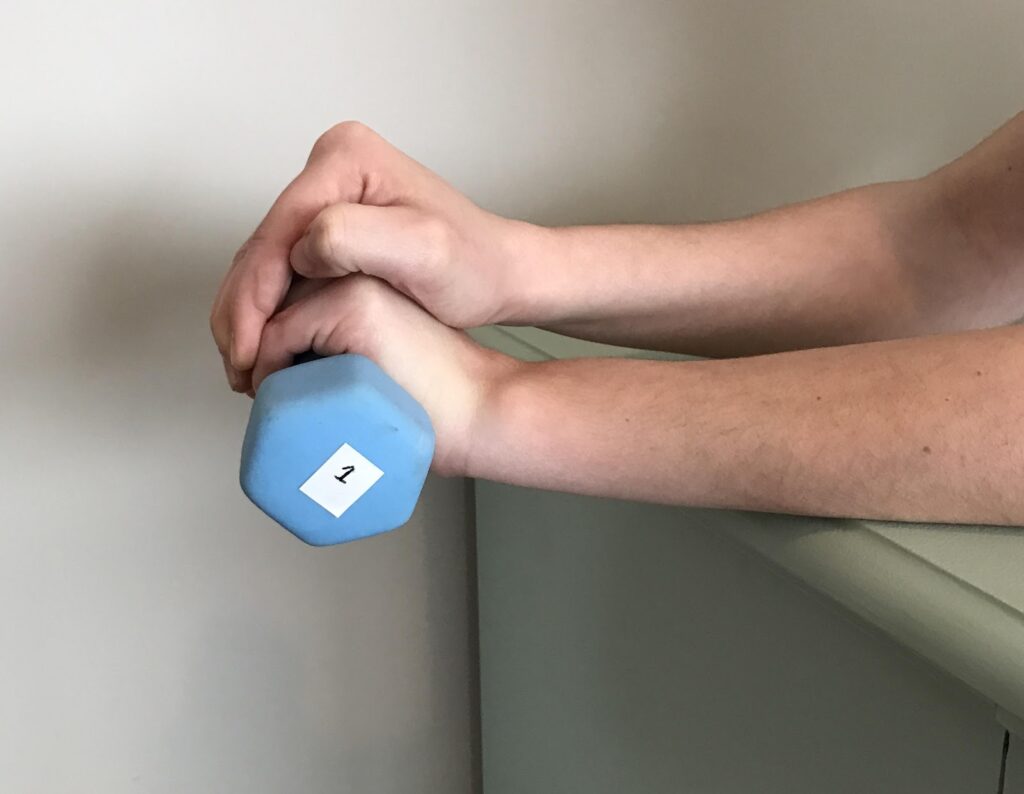
Begin with no weight at all and perform just 10 repetitions once a day. Then, slowly increase your repetitions until you can perform 30 reps without pain. After that, you can hold a 1-pound weight as you do this, keeping a very light grip.
To better visualize that progression, work your way down the chart on the left, progressing only as tolerated. Then, once you can complete 30 reps without pain, add a 1-pound weight and start over with 10 reps, following the chart on the right.
2. Eccentric Flexion
Now we’ll reverse the direction. Flip over your wrist so that your palm is facing up. Hold a 1-pound weight in your injured hand with a loose grip. Using your opposite hand, manually lift your affected hand up to the ceiling. Take away your other hand and slowly lower your affected hand over a 5-second count. Follow the chart above for this exercise too, beginning with just 10 reps and gradually increasing until you can do 30 pain-free.
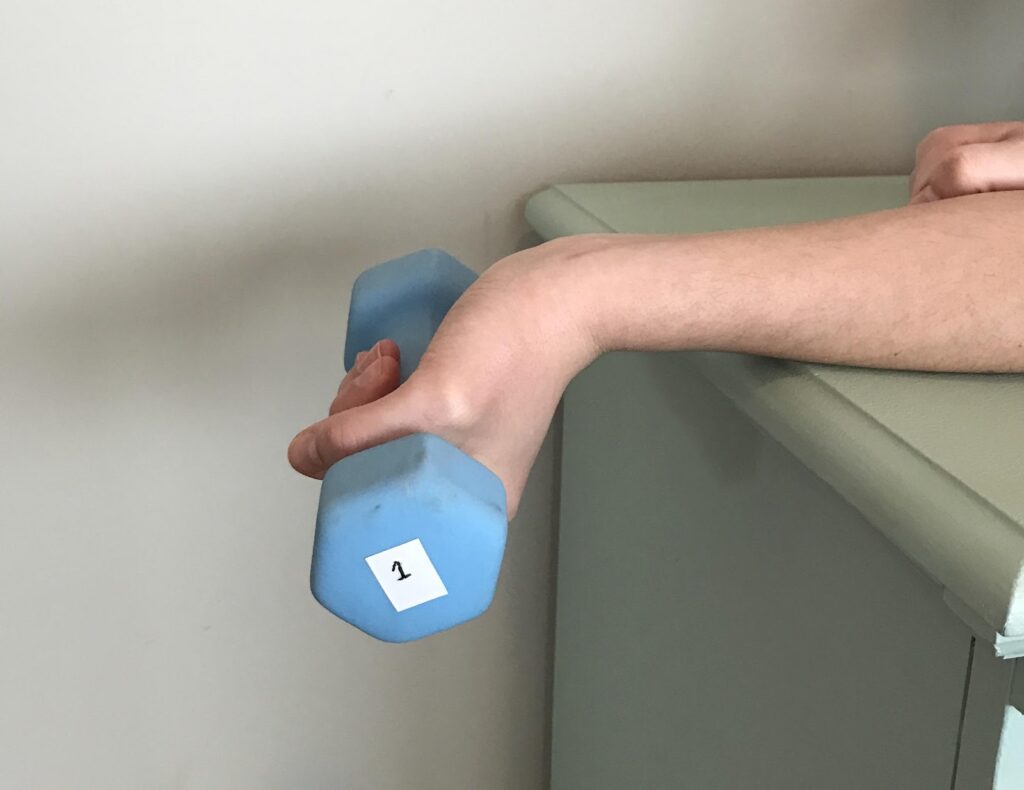
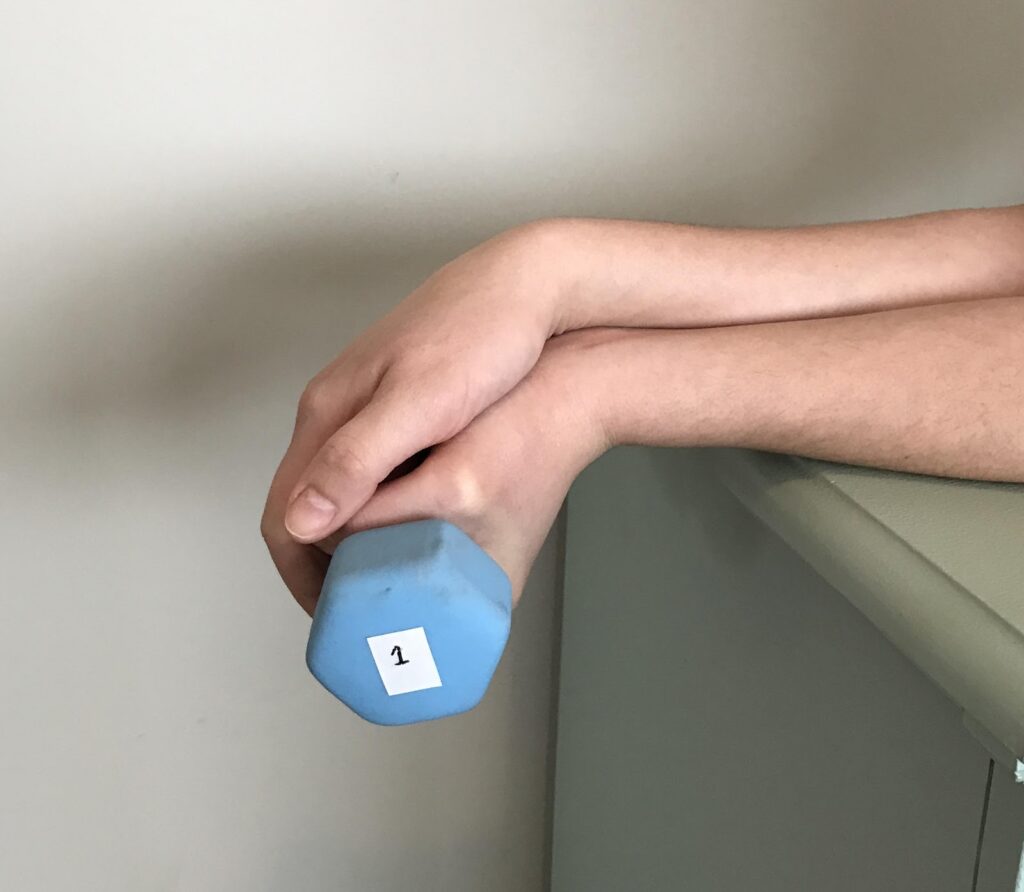
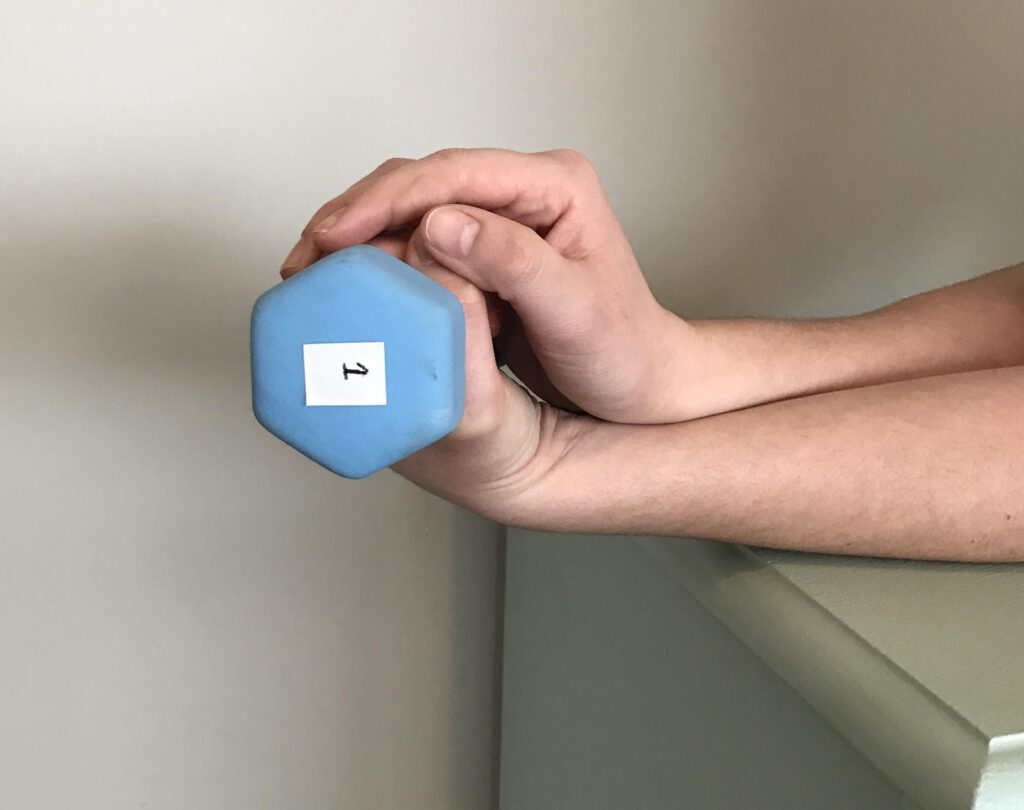
3. Supination/Pronation
Your elbow’s supinator muscle is responsible for rotating your forearm, such as when you turn a doorknob or flip your palms over. Part of tennis elbow rehabilitation includes strengthening this muscle, such as in the following exercise.
Start with your elbow by your side, bent at a 90º angle. Holding a 1-pound weight, slowly rotate your forearm so your palm faces up, then reverse the direction until your palm faces down. Hold each position for 3 seconds before returning to neutral.
Begin with 10 reps at a time, progressing to 30 reps when tolerable.

Practice the above exercises every day for 6 weeks. After that, you can add the next two exercises to gain more strength, improve muscle control, and prevent further injury to your tendon.
4. Finger Extension Exercise – Advanced
Touch your fingers together and secure a rubber band around the middle knuckle joints and thumb. Next, slowly extend your fingers, resisting the rubber band open. Hold this extended position for 5 seconds and release back to the start. Repeat 10 times, once a day.
5. Gripping Exercise – Advanced
For this exercise, use a stress ball or lump of putty. Squeeze it in your hand until you make a fist, holding for 5–10 seconds. Don’t strain as you do this—just apply light to moderate pressure.
Perform this grip strength exercise once or twice a day, for 10 reps each time.
Icing Your Tennis Elbow
Immediately after exercising—or performing other aggravating activities—you should ice your elbow. There are two good methods to try:
- Ice Massage: Freeze a cup of water in a plastic or paper cup. Once solid, tear off the bottom ½–¾” of the cup away to expose the ice block. Then, using a circular motion, massage the ice to your outer elbow for 5–6 minutes. In that time you’ll experience a shock of coldness followed by a burning and stinging sensation and finally numbness.
- Ice Bag: Apply a bag of crushed ice or frozen vegetables directly to the outer elbow for 15 minutes. You can also use a gel ice pack with a thin towel over your skin to prevent burns.
Tennis Elbow Home Exercise Program Sample
When you put all this together, the result is a home exercise program similar to what’s displayed below. Just remember that this is only a sample, and ultimately you should follow whatever tennis elbow exercises and stretches your PT has given you.
Weeks 1–5
| Activity | Secs/Reps | |
| Basic tennis elbow stretch | 15–20 secs | |
| Stretch | Upper trap stretch | 20–30 secs |
| Scapular retraction | 20 reps | |
| Eccentric Extension | 10–30 reps | |
| Strengthen | Eccentric Flexion | 10–30 reps |
| Supination/Pronation | 10–30 reps | |
| Basic tennis elbow stretch | 15–20 secs | |
| Stretch | Upper trap stretch | 20–30 secs |
| Scapular retraction | 20 times | |
| Ice | Ice pack OR ice massage | 15 minutes OR 5 minutes |
Weeks 6–12
| Activity | Secs/Reps | |
| Advanced tennis elbow stretch | 15–20 secs | |
| Stretch | Upper trap stretch | 20–30 secs |
| Scapular retraction | 3 secs; 20 reps | |
| Eccentric Extension | 10–30 reps | |
| Strengthen | Eccentric Flexion | 10–30 reps |
| Supination/Pronation | 10–30 reps | |
| Finger Extensions | 10 reps; 2x/day | |
| Gripping Exercise | 5 secs; 10 reps | |
| Advanced tennis elbow stretch | 15–20 secs | |
| Stretch | Upper trap stretch | 20–30 secs |
| Scapular retraction | 20 times | |
| Ice | Ice pack OR ice massage | 15 minutes OR 5 minutes |
Next Steps: Protecting Your Tennis Elbow at Home
One of the best ways you can protect your elbow and speed its recovery is through activity modification. By that I don’t mean an absence of activity but a mindfulness of your injury throughout the activity. Whether exercising, cooking, shopping, or resting, watch how your actions may be aggravating your tennis elbow, and modify whenever possible.
It’s ok to feel mild discomfort in your activity, but you shouldn’t feel severe pain; persisting through pain will only prolong your recovery. To prevent further injury, modify your activities to make them less harmful to your tennis elbow. For example, whenever you reach for something or carry something, try to keep your palm up instead of down. Your elbow’s tendon is less prone to injury in the palm-up position.





Some activities you may need to avoid entirely. Twisting motions are more likely to aggravate your injured tendon, as well as anything requiring a tight grip. Switch hands or find a way around such a task if possible.
Lastly, your PT may recommend you wear a counterforce strap. This type of tennis elbow brace helps your injured tendon rest by preventing the muscle from fully contracting. You’d wear it throughout the day but never while sleeping or while performing tennis elbow exercises and stretches.
For proper wear, place the strap below your elbow and across the thick part of your forearm. Strap it snug but not tight—you should be able to bend your elbow and even slip a finger in between the strap and your arm. Let your PT know if you experience any pain while wearing the strap or before/after wearing it.
Check out this post for some of the best-rated tennis elbow straps and braces. You can find more information about tennis elbow, as well as other postural injuries, right here on the blog!


